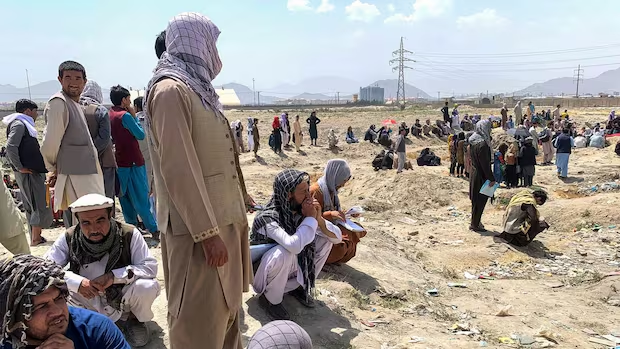Why the White House blames National Guard shooting on program that brought Afghan nationals to the U.S.

A Biden administration program that brought in thousands of Afghan nationals is being blamed by the Trump White House for the arrival of the man suspected of shooting two members of the National Guard in Washington, D.C., on Wednesday.
The 29-year-old suspect, Rahmanullah Lakanwal, arrived in the U.S. on Sept. 8, 2021, through the program known as Operation Allies Welcome (OAW), Department of Homeland Security (DHS) Secretary Kristi Noem said on the night of the shooting.
CIA Director John Ratcliffe confirmed that Lakanwal worked with the U.S. government, including the CIA, “as a member of a partner force in Kandahar.”
Lakanwal applied for asylum during former U.S. President Joe Biden’s term in office, but it was approved this April under the Trump administration.
Since the shooting, some Trump administration officials, including the president, have been blasting the program, saying it provided little or no security vetting for those who entered the U.S.
On Wednesday, the Trump administration said it had stopped processing immigration applications from Afghanistan.
“The Trump Administration is also reviewing all asylum cases approved under the Biden Administration, which failed to vet these applicants on a massive scale,” said DHS Assistant Secretary Tricia McLaughlin, according to Reuters.
Here’s a closer look at the program, its purpose, and questions raised about its vetting processes.
What is Operation Allies Welcome?
Leading up to the U.S. troop withdrawal from Afghanistan, there was pressure from both Republicans and Democrats to help Afghan nationals who were allies of the U.S.
In August 2021, as the Taliban seized control of Afghanistan, then U.S. president Joe Biden launched Operation Allies Welcome, a program meant to help Afghan nationals.
It was particularly aimed at interpreters and translators who had helped the U.S. during the war and feared reprisals from the Taliban regime.
Operation Allies Welcome was a program introduced by Biden, seen here speaking about Afghanistan at the White House on Aug. 16, 2021. It was meant to help Afghan nationals who had aided the U.S. during the war and feared reprisals from the Taliban. (Evan Vucci/The Associated Press)
Those who arrived in the U.S. were granted two years of humanitarian parole, which allows foreign nationals — who would otherwise be considered inadmissible — to temporarily enter the U.S. due to an emergency or “urgent humanitarian reason,” according to the U.S. Customs and Border Protection website.
They were expected to apply for asylum if they wished to remain in the U.S.
Afghans who arrived as part of OAW were processed at one of nine “safe havens” set up at government facilities around the United States and operated in part by resettlement agencies, according to the International Rescue Committee.
Most stayed at the safe havens until nongovernmental organizations helped resettle them.
More than 40 per cent were eligible for Special Immigrant Visas (SIVs) because they took significant risks to support the U.S. or were related to someone who did, according to the DHS website.
Under OAW and the follow-up program Enduring Welcome, which focused on the resettlement process, around 190,000 Afghans resettled in the U.S., according to the U.S. State Department.
How were Afghan people vetted?
According to DHS, the vetting process involved “biometric and biographic screenings.” That included reviewing fingerprints, photos and other biometric and biographic data “for every single Afghan” before they were cleared to travel to the United States, according to the Homeland Security website.
WATCH | Officials give update about shooting of 2 National Guard members:
Washington suspect shot National Guard members ‘without provocation,’ used revolver
Jeanine Pirro, U.S. attorney for the District of Columbia, describes the events surrounding Wednesday’s shooting of two National Guard members, and how the suspect was prevented from causing further damage.
As well, Afghan nationals underwent a primary inspection when they arrived at a U.S. airport, and a secondary inspection was conducted as the circumstances required, the website said.
These security reviews were conducted by intelligence, law enforcement, and counterterrorism professionals from a number of U.S. security agencies.
Why was the vetting process criticized?
Around the time that Afghan nationals were arriving in the U.S., some Republicans raised questions about the vetting process.
They expressed concern that the process allowed people who may pose a security risk to the U.S. to enter the country along with those who had been allies during the war.
For example, Sen. Joni Ernst (R-Iowa) wrote an October 2021 letter to former Defence Secretary Lloyd Austin and ex-Homeland Security Secretary Alejandro Mayorkas that was signed by 15 other U.S. senators. In it, she suggesting that the Biden administration’s security procedures for vetting Afghans were unclear and incomplete.
“We are concerned the hastily developed process creates gaps in security and criminal vetting and risks our Nation’s security,” Ernst wrote.
The letter went on to urge the government to pause relocating more Afghan evacuees to the United States, except for those who had been fully-vetted, held Special Immigration Visas and had completed all appropriate vetting procedures.
Other issues with the program were raised in government reports.
A September 2022 report by the DHS inspector general found that Homeland Security did not always have critical data to properly screen, vet or inspect all Afghan evacuees who arrived as part of the program.
It also said some of the information used to vet evacuees, such as name, date of birth, identification number and travel document data, was inaccurate, incomplete or missing.
Another 2022 DHS inspector general report from that same month also found that officials had struggled to track Afghan evacuees who didn’t stay at the safe havens.
As well, the inspector general wrote that there was no attempt to locate all Afghan evacuees who left the safe havens to verify their compliance with parole conditions.
WATCH | Breaking down Trump’s accusations in aftermath of D.C. shooting:
Trump vows retribution: Washington D.C. National Guard shooting | About That
Two members of the U.S. National Guard were shot in Washington D.C., just blocks from the White House, in what officials are calling a ‘targeted attack.’ After the FBI identified the suspect as an Afghan national, U.S. President Donald Trump linked the attack to poor vetting by a 2021 evacuation program under former President Joe Biden. Andrew Chang breaks down Trump’s accusations and vow for retribution, and what this could signal for the nation’s security.
Images provided by The Canadian Press, Reuters and Getty Images
In a 2022 media release, former Republican Sen. Rob Portman of Ohio said he had consistently supported the resettlement of Afghans “who stood in battle with us and our allies over the last 20 years.”
But he said reports like those from the inspector general proved that the U.S. faced an increased threat due to the Biden administration’s “catastrophic evacuation of Afghans without rigorous or thorough vetting.”
Following Wednesday’s shooting, Shawn VanDiver, president of #AfghanEvac, an organization that helps resettle Afghans who assisted the U.S. during the two-decade war, said in a statement that the group rejects and condemns anyone who uses violence or seeks to use it.
However, the statement went on to note that Afghan immigrants and wartime allies who resettle in the U.S. undergo “some of the most extensive security vetting of any population entering the country.”
“This individual’s isolated and violent act should not be used as an excuse to define or diminish an entire community,” VanDiver said.





